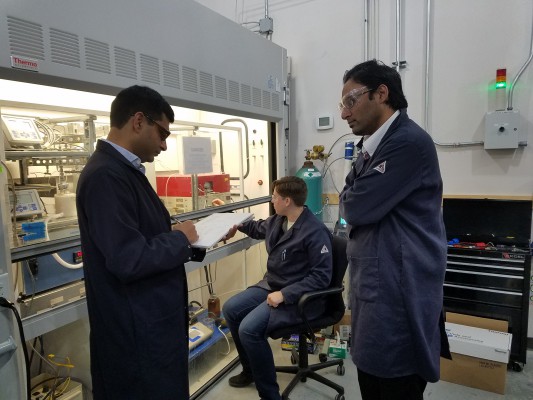The U.S. Department of Energy’s Office of Fossil Energy has awarded Southern Research nearly $800,000 for a project that targets a more cost-efficient and environmentally friendly method of producing some of the most important chemicals used in manufacturing.
Southern Research is developing a novel nano-engineered catalyst-driven process for the production of light olefins, such as ethylene and propylene, using carbon dioxide, or CO2, from coal-fired flue gas and lower alkanes derived from shale gas as feedstocks.

Olefins are a class of chemicals that serve as building blocks for a sweeping variety of products such as packaging, plastics, textiles, paints and electronics. Industrial demand for olefins such as ethylene and propylene is rising with improving living standards across the world.
Ethylene and propylene are the petrochemicals produced in the greatest volumes today. Current production methods are capital- and energy-intensive, and emit significant amounts of greenhouse gases.
Southern Research’s new production method, combining CO2 with readily available shale gas, promises to have meaningful economic and environmental impacts.
In addition to this novel approach of producing olefins, Southern Research’s Durham, North Carolina, facility is exploring new ways to make chemicals such as acrylonitrile and fuels from sources such as non-food renewable feedstock, and coal, waste emissions and natural gas, respectively.
ENVIRONMENTAL BENEFITS
Production techniques for ethylene, which is manufactured in amounts greater than any other chemical, typically use naphtha or ethane as raw materials, and require a large amount of energy to crack apart molecules.
Amit Goyal, Ph.D., manager, Sustainable Chemistry and Catalysis and principal investigator, said Southern Research’s innovative process concept can use CO2 captured from coal-fired power plants, or derived from any source, to produce light olefins. The new technique can yield significant environmental benefits, he added.
“Ethylene alone accounts for 1 percent of the world’s energy consumption and 180 to 200 million tons of CO2 emission,” Goyal said. “Due to the large magnitude of ethylene production, any reduction on the energy requirement will be highly impactful.”
The approach would reduce carbon dioxide emissions from coal-fired plants, the top emitters of the colorless, odorless gas in the U.S power sector. In 2015, coal-based power plants in the United States emitted nearly 1.4 billion metric tons of CO2.
“Coal is abundant and cheap, making it a vital energy source,” said Jadid Samad, Ph.D., advanced chemical engineer and co-principal investigator for Southern Research. “A smart solution to the issue of emissions from coal-fired power plants lies in the prospect of using CO2 as feedstock to produce valuable chemicals.”
Samad said Southern Research’s approach on the project directly supports the Carbon Use and Reuse research and development portfolio being assembled by the U.S. Energy Department’s Office of Fossil Energy. The portfolio is developing and testing novel approaches that convert captured CO2 from coal-fired power plants into useable products.
The funding from the Office of Fossil Energy for Southern Research’s project is $799,422. The office has committed $5.9 million to funding projects to support its Carbon Use and Reuse R&D portfolio.
Atlanta-based Southern Co. is teaming with Southern Research on the project and will provide the research team with the composition of various flue gases generated in a utility plant. In addition, a petrochemical consultant will provide guidance on catalyst development, as well as scale-up and commercialization aspects of the project.